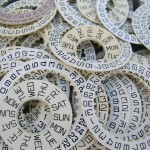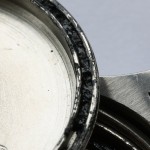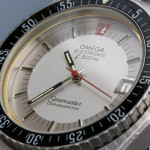I’m sure all watches and / or movements have well known issues or foibles, and the movement used in the Omega f300 models is no exception. It is also worth remembering that the same movement is also used in many other electronic watches from the 1970s i.e. Tissot Tissonics, Longines Ultronics, Titus Tuning Fork, IWC Electronic, Zenith Electronic, Baume & Mercier Tronosonic etc, so the top two in my list below also apples to these watches.
1. Calendar Wheels
Top of the list are the calendar wheels. They are made of a brittle plastic and if an owner uses the date quick set feature (crown out to first position) between the hours of 21:00 and 02;00, they will likely damage the teeth of this plastic wheel. If the damage is mild, the date will then fail to automatically advance at midnight on the affected dates although they can usually still be advanced manually using the quick set feature. In severe cases of damage, even the quick set feature will fail to work and then the date will be stuck permanently on the affected date until the date wheel is replaced. The date only models (Omega cal. 1250 / ESA 9162) are affected much more than the day & date models (Omega cal. 1260 / ESA 9164); the latter has slightly thicker plastic calendar wheels and as a result, do not break nearly as often.
At least 50% of the Omega f300 date-only models that I see have broken calendar wheels and today I replaced this plastic wheel with newly commissioned stainless steel date wheels that are made in Germany. But there are several different date wheels types: background colour, text colour, text orientation and position of crown in relation to the dial date window. At the moment, the only date wheels being made are those with black-text-on-white-background and with both the crown and date window at the 3 o’clock position….all other types are obsolete and unobtainable. Some of the Omega f300 Seamaster Cone models have the crown at two positions; date wheels for these are not available at the current time. The Omega f300 Speedsonics (cal. 1255 / ESA 9210) also suffer in a similar way; their thin day wheels often jam and then either break in half or their teeth become deformed. The only cure is a new day wheel.
2. Coils
They fail and often for no apparent reason. By “fail”, I mean there is a break in the windings and they then read as open circuit on an Ohm meter. The coils on Bulova Accutrons (cousin to the f300s) also fail but on these, the reason is usually visible and is often caused by either physical damage or battery corrosion. But on the f300 coils, there is often no sign of why they have gone open circuit — it’s a mystery. Much less often, the transistor fails but this is usually always due to battery corrosion and is very visible. Another point worth mentioning. The cream coloured plastic used for the coil / electronics moldings will soften and dissolve in solvents often used by watch repairers. So while you might use a little solvent to clean the jewels on the end of the indexing pawls, it is best to keep it well away from the coil assemblies! Those are the two main problems out of the way and the remaining list are things that I often come across when repairing these watches.
3. Index Wheel
Nothing inherently wrong with the f300 index wheel; it is as fragile as the ones found in Accutrons. But they do wear out and loose their teeth, especially if the pressure of the indexing pawls is too great. They are lots of stories about never turning the hands backwards on an f300 because you’ll strip the teeth on the index wheel — rubbish. On a well worn index wheel, the second hand will sometimes spin forward or backwards when winding the hands, but by this stage, the index wheel is probably useless anyway. And a spinning second hand does not always indicate a worn index wheel; it can also occur if the index pawls are poorly adjusted.
4. Gaskets
Or more specifically, rubber case back gaskets that turn to a gooey mess. Obviously not restricted to Omega f300 watches and is probably a common occurrence in many 1970s watches. After 40 years, the case back gaskets either go very hard or they turn into liquid rubber / tar. In the latter case, it is quite serious and often gets onto the tuning fork and coils and stops the movement; it can also find its way onto the dial. It is a real pain to clean this tar off everything and is one of my least favorite jobs — it gets everywhere: on your tools, bench and hands.
- Omega f300 Case Back Gaskets Turn To Tar
- Omega f300 Case Back Gaskets Turn To Tar
- Omega f300 Case Back Gaskets Turn To Tar
- Omega f300 Case Back Gaskets Turn To Tar
- Omega f300 Case Back Gaskets Turn To Tar
5. Pivots
Unlike a conventional manual / auto wind watch, there are relatively few wheels in the f300 movement, so less pivots to cause problems. However, the one pivot that does wear out sometimes is the centre second wheel — and it only wears out due to dirt and lack of lubrication.
6. Bezels
If I had a stock of new Omega f300 Seamaster 120m divel bezels, I’d be a rich man. This part become obsolete many years ago and perfect, secondhand ones are hard to find. Being a professional diver’s watch, the bezel have often had a hard life and the acrylic printed insert is often scratch, chipped and / broken.
7. Bracelets
There are lots of different Omega f300 bracelets but those that attached to the watch case with 2 small screws at each end (4 in total) usually cause problems — not with the bracelet but with the threaded case lugs. The lugs are often bent and the threads are often stripped or old screws left broken in them. Nightmare!










